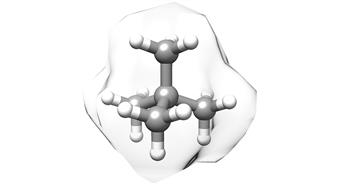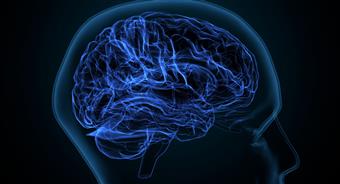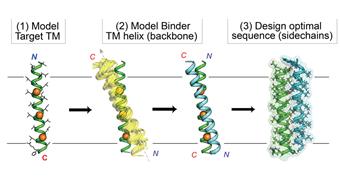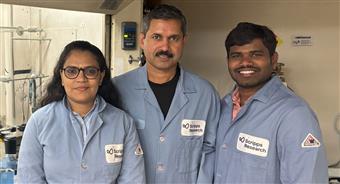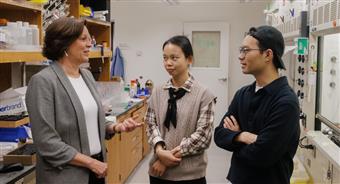
Wiring the eyes to the brain for color vision Color-discriminating cone cells in the retina use a pair of adhesion proteins to connect to the brain.
September 02, 2020
JUPITER, FL Cone cells in the retina, which are meant to work in daylight and enable color vision, normally use a specific set of proteins during development to connect to other nerve cells in the retina and the brain, according to a study led by neuroscientists at Scripps Research.
The finding, reported in the Proceedings of the National Academy of Sciences, solves the mystery of how cones form their distinctive brain connections, giving humans and other animals their sophisticated and powerful vision sense. The basic neuroscience discovery may aid future efforts to boost vision lost due to retina degeneration, which is common in the elderly, and may potentially help connect lab-grown light-sensing prosthetics that cure blindness.
Solving a connection quandary
Our eyes are equipped with two kinds of light sensors known as photoreceptors: the rods that we use for seeing under very dim lighting and cones that we use ubiquitously throughout the day to see things in color.
Detecting the light, however, is only the first step for us to be able to see. Photoreceptors then need to be able to transmit their signals to the brain. They do so by establishing highly selective contacts with other neural cells in the retina that ultimately pass the information to the brain, much like plugging an electrical device into a socket.
But what makes the plug match the socket so that rod and cones can connect?
The research team, led by principal investigator Kirill Martemyanov, PhD, professor and chair of the Department of Neuroscience at Scripps Research's Florida campus, discovered that a pair of cell adhesion molecules called ELFN1 and ELFN2 does the trick.
It has been a thrilling scientific detective story, Martemyanov says.
Back in 2015, his team discovered that a protein called ELFN1 enables rod cells to hook up to nearby nerve cells in the retina. A rod cell is a long, slender cell with photosensitive molecules at one end for detecting light photons, and a stalk-like projection at the other end for sending their signals brainward.
Martemyanov and his team found that rod cells, as they develop in the retina, produce ELFN1 and secrete it from their output ends and that this induces nearby nerve cells called bipolar cells, which are connected to the brain via the optic nerve, to form connections, or synapses, with them. Once these synapses are formed, the rod cells can start sending their light-sensing signals to the vision-processing regions of the brain. The scientists found that mice engineered to lack the gene for ELFN1 were essentially night-blind, lacking rod-based vision but retaining cone-based vision.
That clarified how rod cells work. But what about cone cells?
We found in that study that cone cells normally don't express ELFN1, Martemyanov says, so we started looking for a protein like ELFN1 that is produced in cone cells and has a similar role in inducing connections between these cells and cone-specific bipolar cells.
A clearer view of the vision system
The process of finding this ELFN1-like cone protein required studies using animals whose vision sense is dominated by cone cells, not rod cells whereas mice and even humans use mostly rod cells. Martemyanov and his team therefore studied cone-dominant ground squirrels and tree shrews to identify the protein that does for cones what ELFN1 does for rods. The protein was already considered such a close relative of ELFN1 that it had been named ELFN2.
But the hunt was not over, because when Martemyanov and his team engineered knockout mice that lack the gene for ELFN2, the retinas of the mice developed normally, with apparently functional cone cells.
Eventually, the researchers were able to determine that ELFN1, though it normally isn't produced detectably in cones, is produced in cones to perform ELFN2's wiring function if ELFN2 is missing.
It's a classic example of resilience in an important biological system, Martemyanov says.
With the new discovery, he says, we finally know how two types of primary photoreceptor cells, which we rely on for all of our vision sense, are sending their information to the brain. And importantly, this fundamental knowledge may one day translate into novel treatments for vision loss.
Interplay between cell adhesion molecules governs synaptic wiring of cone photoreceptors was authored by Yan Cao, Yuchen Wang, Henry Dunn, Cesare Orlandi and Kirill Martemyanov, of Scripps Research; Nicole Shultz, Naomi Kamasawa, and David Fitzpatrick, of Max Planck Florida Institute; Wei Li of the National Eye Institute; Christina Zeitz of Sorbonne Universit ; and William Hauswirth of the College of Medicine at the University of Florida at Gainesville.
The study was funded by the National Institutes of Health (EY018139 and EY028033), the French Muscular Dystrophy Association, Retina France and the Agence Nationale de la Recherche.
Neuroscience Martemyanov, Kirill
More from Scripps
12/04/2024
Scripps Research chemists devise easier new method for making a common type of building block for drugs Scientists transform simple linear amines into saturated...
06/04/2024
A simple, inexpensive way to make carbon atoms bind together A Scripps Research team uncovers a cost-effective method for producing quaternary carbon molecules,...
04/04/2024
Developing a vaccine for the zombie drug xylazine Scripps Research chemical biologists design an early proof-of-concept vaccine that could lead to the first...
30/03/2024
How blocking a neural receptor responsible for addiction could reduce alcohol use A Scripps Research team found that a new therapeutic that targets the kappa op...
13/03/2024
New computational strategy boosts the ability of drug designers to target proteins inside the membrane Customized-design approach could streamline the design of...
29/02/2024
Scripps Research scientists reveal how first cells could have formed on Earth New phospholipid discovery brings researchers closer to understanding how primordi...
29/02/2024
How molecular handedness emerged in early biology Scripps Research chemists fill a major gap in origin-of-life theories.
February 28, 2024
LA JOLLA, CA Mole...
22/02/2024
Snaking toward a universal antivenom Scripps Research scientists discovered antibodies that protect against a host of lethal snake venoms.
February 21, 2024
...
06/02/2024
Calibr-Skaggs announces expansion of option and license agreement with AbbVie to develop novel cell therapies for solid tumors and autoimmune diseases
AbbVie...
26/01/2024
Re-energizing mitochondria to treat Alzheimer's disease Scripps Research team restored neuron-to-neuron connections in human cells.
January 25, 2024
LA JO...
24/01/2024
100 years of Science Changing Life: Scripps Research celebrates a century of transforming human health For the last century, institute leaders and renowned scie...
23/01/2024
New technology lets researchers track brain cells' off switches The method could shed light on what goes awry in numerous brain conditions when neurons ar...
09/01/2024
Three decades of giving: Announcing the Calibr-Skaggs Institute for Innovative Medicines The ALSAM Foundation, founded by the Skaggs family, provides lasting g...
04/01/2024
Life science entrepreneur Gene Lay joins Scripps Research Board of Directors Lay, founder of the global biotech company BioLegend, brings invaluable experience ...
21/12/2023
Taming a plant-derived toxin Scripps Research team modifies the traditional poison picrotoxinin for potential neurological drugs and anti-parasite treatments. ...
19/12/2023
Scripps Research Executive Vice President Eric Topol gives TED talk on transformative power of AI in medicine Topol provides an overview of how AI models can i...
13/12/2023
New AI-powered algorithm could better assess people's risk of common heart condition Early detection of atrial fibrillation can reduce the risk of stroke an...
07/12/2023
Nanoparticle flu vaccine design shows promise in early tests Scripps Research-designed vaccine could provide broad, enduring protection against influenza A str...
16/11/2023
Numerous Scripps Research scientists named Highly Cited Researchers Clarivate's annual, global list represents researchers who have demonstrated significant...
07/11/2023
Multiple sclerosis drug invented at Scripps Research slows long-term devastating disease progression Late-breaking data reinforces the effectiveness and safety ...
05/10/2023
Keren Lasker named a 2023 Moore Inventor Fellow The prestigious award will support Lasker's inventive research in membraneless organelles and their applica...
22/09/2023
Michael Bollong named a 2023 Amgen Young Investigator The prestigious award will support Bollong's research identifying new molecular targets and therapeuti...
09/09/2023
Philip Dawson receives 2024 American Chemical Society National Award Dawson is honored with the Arthur C. Cope Late Careers Scholar Award for his foundational c...
07/09/2023
Scripps Research chemists devise a method for C-H activation of alcohols The method represents a new toolkit for making drugs and other compounds.
September 06...
31/08/2023
Scripps Research receives $1.5M to surveil infectious disease threats in wastewater Bill & Melinda Gates Foundation award to support the development of multi-pa...
16/08/2023
How cold temperatures trigger the brain to boost appetite Scripps Research scientists' discovery could lead to new weight loss and metabolic health treatmen...
08/08/2023
Human antibody that targets carfentanil, fentanyl and related opioids reverses overdose effects in preclinical study Scripps Research-developed antibody therapy...
04/08/2023
How sensory neurons impact the gut Scripps Research scientists show that the receptor PIEZO2 in sensory neurons controls gut motility and transit time, which a...
26/07/2023
AbbVie and Calibr Expand Strategic Collaboration to Advance Several Preclinical and Early-stage Clinical Assets The expanded strategic collaboration will advan...
23/07/2023
Scripps Research scientists develop AI-based tracking and early-warning system for viral pandemics Machine-learning system effectively predicts emergence of pro...
19/07/2023
Monitoring T cells may allow prevention of type 1 diabetes Scripps Research study shows that analyzing T cells in blood samples could be used to select at-risk ...
19/07/2023
Scripps Research mourns passing of leading organic chemist Albert Eschenmoser Eschenmoser pioneered key reactions in synthetic chemistry and shaped the understa...
15/06/2023
Scripps Research awarded $46.8 million by NIH to promote human health through innovative translational science and training The Translational Institute is harne...
13/06/2023
Scripps Research's Danielle Grotjahn named 2023 Pew Scholar in the Biomedical Sciences The award will support Grotjahn's study of how cells assemble the...
31/05/2023
Crossing the ring: new method enables C-H activation across saturated carbocycles Scripps Research chemists add another powerful tool to their molecular editin...
24/05/2023
Scripps Research develops behind-the-scenes tool for better biomedical data discovery The new resource makes datasets more discoverable for life science communi...
19/05/2023
Scripps Research neuroscientist Hollis Cline elected to American Academy of Arts and Sciences Cline is recognized for her discoveries about the role of sensory ...
19/05/2023
Scripps Research's Skaggs Graduate School awards doctoral degrees to 31st graduating class Commencement ceremony will be livestreamed via Zoom and on instit...
13/05/2023
A better route to benzocyclobutenes, sought-after building blocks for drugs Scripps Research chemists devise a new, C-H activation-based method for the synthesi...
09/05/2023
Renowned Scripps Research professor Jeffery Kelly elected to National Academy of Sciences Kelly's groundbreaking work on protein misfolding has led to thera...
28/04/2023
Mirror-image molecules pave new path for cancer drug discovery By comparing how mirror image versions of small molecules impact clusters of proteins, Scripps R...
22/04/2023
How alcohol consumption contributes to chronic pain A Scripps Research team showed how both alcohol intake and alcohol withdrawal can lead to increased pain and...
21/04/2023
Xin Jin receives dual awards to study autism risk genes in neurodevelopment Major grants from the National Institutes of Health and California Institute for Reg...
20/04/2023
Trim the sugar: New HIV vaccine design improves immune response Scripps Research vaccine candidate headed for clinical trials.
April 19, 2023
LA JOLLA, CA A...
18/04/2023
Therapeutic can seek and destroy potent opioid to treat overdoses Scripps Research chemists developed a new biologic to work against the synthetic opioid carfen...
07/03/2023
How heavy alcohol consumption increases brain inflammation The findings by a Scripps Research team point toward a potential new drug target for treating alcohol...
02/03/2023
Scientists find human antibodies that can block multiple coronaviruses including SARS-CoV-2 Results from a Scripps Research and UNC team pave the way for a vacc...
28/02/2023
$10 million grant funds Scripps Research Alcohol Research Center through its 50th year The five-year grant supports research into the neurobiology of alcohol us...
28/02/2023
Immune system drug shows promise in treating alcohol use disorder, a Scripps Research clinical trial reports Scientists at Scripps Research found that apremilas...
23/02/2023
Chemically poisoned protein acts as a molecular switch to spur cancer formation The discovery triggered development of a new potential drug to eliminate tumor...
 Wiring the eyes to the brain for color vision Color-discriminating cone cells in the retina use a pair of adhesion proteins to connect to the brain.
Wiring the eyes to the brain for color vision Color-discriminating cone cells in the retina use a pair of adhesion proteins to connect to the brain.














